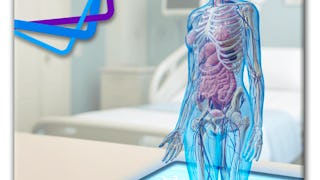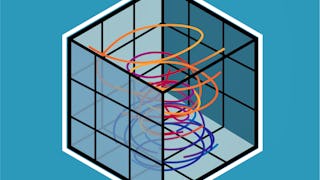Visualisation is a rapidly progressive specialty in academia, research and industry, and becoming the future of science. With the advancement of digital technologies and their applications, biomedical visualisation is an evolving and popular field. With new techniques and technologies to image, process and analyse data related to the human body, and its biological processes, it is at the forefront of the digital revolution. Why not view our course trailer video. Copy and paste this link into your browser https://youtu.be/vB_QcIVSiTs

Gain next-level skills with Coursera Plus for $199 (regularly $399). Save now.

(529 reviews)
Recommended experience
What you'll learn
Define and describe anatomical terminology related to the human body
Describe the various body systems, what comprises them, and how they relate to function
Create your own 3D modelling and animations using industry standard, open-source software (Blender)
Analyse various visualisation techniques and methods, and be able to apply them to areas of biomedical science
Skills you'll gain
Details to know

Add to your LinkedIn profile
12 assignments
See how employees at top companies are mastering in-demand skills

There are 4 modules in this course
Module 1 will cover introductory material of visualisation and its applications, as well as exploring the basis of human anatomy. You will learn about a historical journey of "visualisation" to the present day advances and uses with biomedical science. Exploring the human body, you will learn its structure and function; the body systems and their roles; as well as learning frequently used terminology within anatomy. Examples of visualisation techniques will be covered, and as a learner you will be able to name examples as and evaluate their advantages and disadvantages.
What's included
5 videos8 readings3 assignments3 discussion prompts
Module 2 will give you an introductory lesson into 3D modelling software "Blender" and modelling terminology. By completion you will be able to create your own organic 3D models and animations using Blender. You will be taught a brief introduction to modelling and its vast variety of uses within Biomedical Science. The theory and process of segmentation from patient imaging data will be explored as another option to obtain realistic 3D models.
What's included
5 videos6 readings3 assignments3 discussion prompts1 plugin
Module 3 will introduce virtual (VR) and augmented reality (AR). The history and background of virtual reality will be explored, and how augmented reality rose in popularity within this field as well. This week will allow you as a learner to hear interviews with VR and AR experts. They will discuss their research, theory and some of the applications of this technology in biomedical science. The wide variety of applications will be taught, and why it has become such a popular tool in research, teaching and in other areas.
What's included
5 videos8 readings3 assignments3 discussion prompts1 plugin
Module 4 is the concluding module for Biomedical Visualisation. New theory that will be introduced are Mixed and 'Extended reality' as a whole, and what could potentially come of the realities in the future. This week is for the learner to reflect on what they have learned throughout this course. When to best use visualisation techniques; their advantages and disadvantages; and how you could use what you have learned throughout the course for future projects in your area of interest.
What's included
6 videos11 readings3 assignments3 discussion prompts
Offered by
Explore more from Health Informatics
 Status: Free Trial
Status: Free Trial Status: Preview
Status: PreviewUniversity of Illinois Urbana-Champaign
 Status: Preview
Status: PreviewNortheastern University
 Status: Preview
Status: Preview
Why people choose Coursera for their career




Learner reviews
529 reviews
- 5 stars
69.37%
- 4 stars
24%
- 3 stars
4.34%
- 2 stars
1.51%
- 1 star
0.75%
Showing 3 of 529
Reviewed on Aug 29, 2024
Great work by the entire team. Solid content with easy-to-understand lectures and engaging practical work.
Reviewed on Jul 25, 2022
I absolutely loved the course. The contents were prepared to help us understand easier and opened many vistas of imagination about my biomedical field.
Reviewed on May 28, 2020
It is very useful for me . It helps me to understand the Future technology thank you University of Glasgow . Thank u so much.i am happy for your work of teaching
Frequently asked questions
To access the course materials, assignments and to earn a Certificate, you will need to purchase the Certificate experience when you enroll in a course. You can try a Free Trial instead, or apply for Financial Aid. The course may offer 'Full Course, No Certificate' instead. This option lets you see all course materials, submit required assessments, and get a final grade. This also means that you will not be able to purchase a Certificate experience.
When you purchase a Certificate you get access to all course materials, including graded assignments. Upon completing the course, your electronic Certificate will be added to your Accomplishments page - from there, you can print your Certificate or add it to your LinkedIn profile.
Yes. In select learning programs, you can apply for financial aid or a scholarship if you can’t afford the enrollment fee. If fin aid or scholarship is available for your learning program selection, you’ll find a link to apply on the description page.
More questions
Financial aid available,







